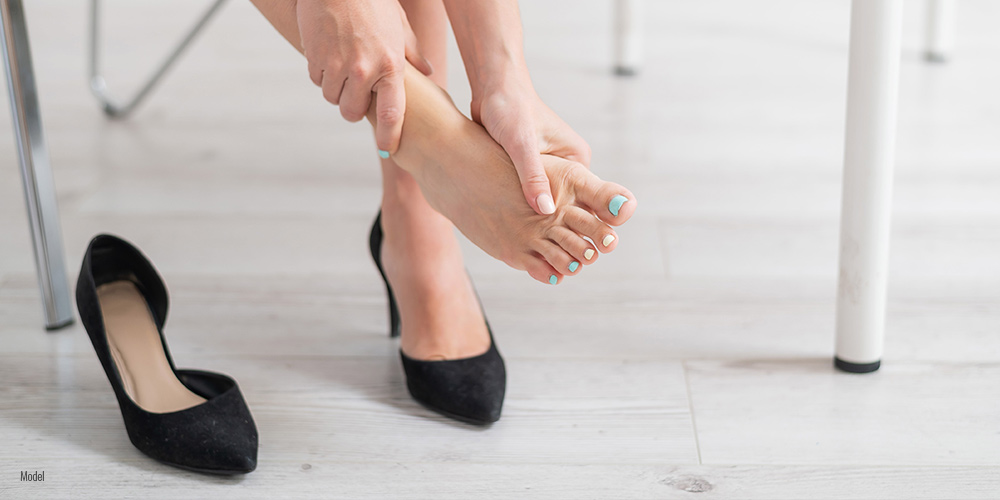How to Find Hammertoe Pain Relief
Posted March 20, 2025 in Hammertoes

Do your shoes pinch? Is walking becoming painful? Those bent toes might be hammertoes, a foot problem that bothers millions of Americans every year. Luckily, you don’t have to live with hammertoe discomfort. From simple home treatments to medical solutions, this guide offers several ways to ease your pain and explains how surgical correction can help if more conservative methods don’t provide results.
5 Min Read:
What Causes Hammertoe Pain?
Hammertoe pain starts when your toe bends unnaturally. The tip points down while the middle joint sticks up. This odd position puts pressure on areas of your toe not meant to bear weight. Over time, your shoes rub against this raised joint, creating painful spots.
The problem begins with an imbalance in your foot muscles and tendons. Some factors that contribute to this imbalance include:
- Wearing shoes that are too tight or narrow in the toe area
- Injuries to your foot or toes
- Genetic predisposition to foot problems
- Arthritis or nerve damage in your feet
As hammertoes progress, the affected toes become less flexible. You might start with a “flexible” hammertoe that you can still straighten by hand. Without treatment, it can turn into a “rigid” hammertoe that stays permanently bent. This stiffness makes walking uncomfortable and can lead to corns, calluses, and changes in how you walk to avoid pain.
However, there are a few things that you can do to help with hammertoe pain relief.
Lifestyle Changes
Change daily habits that can exacerbate hammertoe pain and make your condition worse. Tight, pointed shoes force your toes into unnatural positions day after day. High heels add extra pressure by pushing your feet forward. Even sitting with crossed legs for hours can strain foot muscles and worsen toe alignment over time.
Switching to better footwear can make a big difference. Look for comfortable, supportive shoes with roomy toe boxes that allow your toes to spread naturally. Good shoes should have arch support, low heels (less than one inch), and soft, flexible materials.
Ice Therapy
Hammertoes often become inflamed and swollen, especially after long periods of standing or walking. Ice therapy works well for reducing this swelling and numbing pain temporarily. After a day on your feet, try wrapping an ice pack in a thin towel and applying it to your affected toes for 15–20 minutes. This cooling treatment constricts blood vessels, which limits fluid buildup in the area and calms irritated tissues.
For best results, prop your foot up while icing to further reduce blood flow to the area. You can repeat this process two to three times daily when pain flares up. Many people find ice therapy particularly helpful after trying new shoes or walking more than usual, when hammertoe pain tends to intensify.
Toe Taping
Your provider might suggest using medical tape to hold your toes in the correct position. This method gently realigns the bent joint while allowing tight tendons to stretch gradually. Taping typically involves wrapping the affected toe and anchoring it to a healthy neighboring toe. Some cases need a figure-eight wrap, while others work better with straight taping. The effectiveness depends on your hammertoe’s severity and cause, so always consult with a podiatrist before starting.
Cushions and Pads
Looking for quick hammertoe pain relief? Toe pads from your local drugstore might be the answer. These small cushions slip right between your curved toe and shoe, stopping the painful friction that happens with every step. The better products use soft gel or moldable silicone that conforms to your unique toe shape while softening impact. Foot pain varies widely from person to person, so you might need to sample a few different styles before finding your perfect match. What works for someone else might not work for you.
Removing Corns and Calluses
Hammertoes often create corns and calluses, those painful, hardened skin patches that form from constant friction. Corns typically appear on top of toes, while calluses develop on weight-bearing areas underneath. Removing these tough spots can significantly reduce discomfort and make walking easier again.
Start by soaking your feet in warm water for about 10 minutes. Then, gently rub the thickened skin with a pumice stone using circular motions. Apply moisturizer afterward to keep the area soft. Remember to use light pressure and avoid cutting the skin, as this could lead to infection.
What If My Hammertoe Pain Persists?
While the methods we’ve covered work well for most people, severe hammertoes may require surgical correction. In these cases, finding a qualified podiatrist is your best course of action. During the procedure, the surgeon realigns the bent joint and may insert small pins or screws to keep your toe straight while it heals.
Surgery might sound intimidating, but many patients find it brings lasting relief after trying other treatments without success. Hammertoe recovery typically lasts four to six weeks, with most people using a special shoe and possibly a cane during the initial healing phase. Many patients report being able to return to regular footwear and activities within a few weeks, finally free from the persistent pain of hammertoes.
Learn More About Hammertoe Treatment in New York City
You don’t have to suffer from hammertoe pain a minute longer. The qualified team at Chelsea Foot and Ankle is here to support your first step toward pain-free walking. Call us at (646) 929-4149, or visit our contact page to schedule your consultation today.
